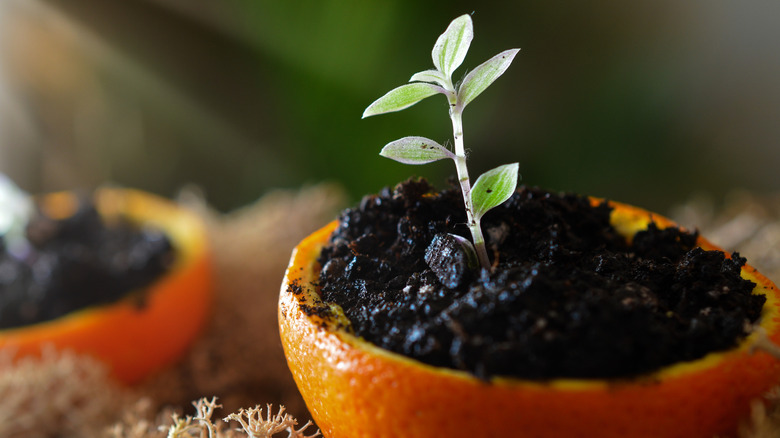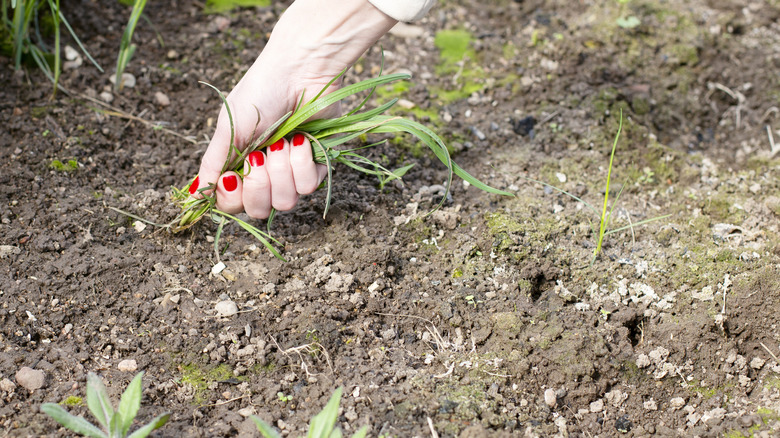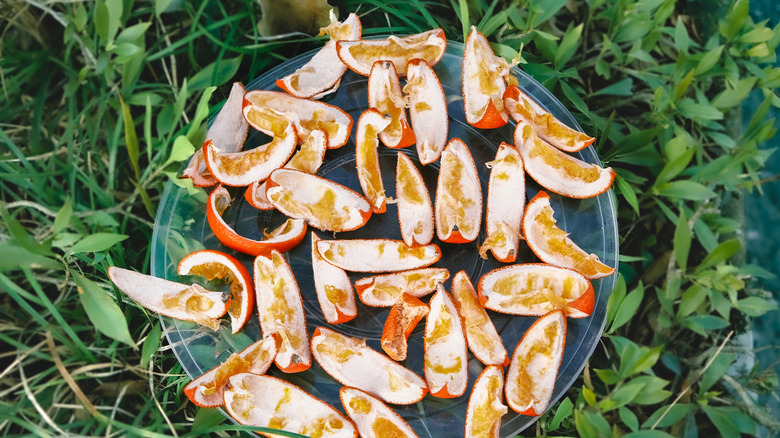How To Use Orange Peels To Help The Plants In Your Garden Thrive
If you're looking for easy, natural ways to boost your garden, orange peels might be one of the most overlooked tools at your fingertips. While many gardeners already know how to compost orange peels, fewer realize how useful these kitchen leftovers can be on their own. What makes orange peels so valuable in the garden is their natural mix of nutrients and oils, which can serve multiple roles beyond just as compost material. Orange peels can kill ants, support plant growth, and even help with weed control.
If you enjoy starting seeds indoors, orange peels can even double as biodegradable seed pots as well. Fill an empty peel with soil and add a few seeds. When the seedlings are ready to go outside, plant the whole thing directly into the ground. The peel will decompose naturally, feeding the soil while helping reduce transplant shock. It's a clever way to reuse food scraps, and one that many gardeners end up using again once they see how well it works. With so many uses for orange peels in the garden, why throw away this kitchen scrap?
Natural pest control with orange peels
The natural oils in orange peels, especially d-limonene and linalool, act as organic insecticides. D-limonene targets the nervous systems of insects like ants, killing them on contact. These compounds are commonly used in eco-friendly pest control because they're effective yet break down quickly in the environment. The products can work against pests like aphids, mites, fleas, wasps, and fire ants.
For everyday garden use, chopped orange peels can be scattered around the base of plants to discourage pests from getting too close. The peels' strong scent and bitter compounds act as a natural repellent, not just to insects but even to animals like cats, who may avoid areas with a strong citrus smell. However, the scent doesn't last forever. As the peel dries out, its repellent effect fades.
Another way to use orange peels is as a natural slug trap. Just place a hollowed-out half peel upside down in your garden overnight. Slugs are drawn to the damp, citrusy space underneath. By morning, you can collect the peel and toss the pests, helping keep your plants safe without using bait or poison. However, to keep pests away long-term, you'll need to replace old peels regularly or switch to stronger methods, like making a citrus peel spray. To make a basic orange peel spray, boil a few orange peels in a cup of water for about ten minutes, then let cool. Strain out the solids and pour the liquid into a spray bottle. This can target slugs, whiteflies, fruit flies, and more. Reapply every three to four days for continued protection.
Weed suppression benefits of orange peels
While orange peels are often praised for their pest-repelling powers, recent research suggests they may also play a role in natural weed control. According to a study published in the Pakistan Journal of Weed Science Research, dried and powdered orange peels contain natural chemicals that can stop weeds from growing by interfering with their seeds and roots.
In a greenhouse trial, researchers applied around 1 ½ ounces of dried orange peel to the soil a week before sowing bean seeds. The test showed that weeds like mallow and canary grass — both common in the U.S. — didn't grow as much, while the bean plants became healthier and produced more. This likely happened because the orange peels made it harder for weed seeds to sprout and develop roots.
For gardeners seeking sustainable options, this method offers a chemical-free alternative to commercial herbicides. Orange peels act much like a natural pre-emergent, targeting weeds before they sprout. As the peels break down, they enrich the soil with organic matter, giving your garden an extra boost. Though more field testing is needed, this early research points to a practical way to manage weeds in an eco-friendly garden.
Orange peels can double as a natural fertilizer for your garden
Another clever way to put kitchen scraps to good use is by turning orange peels into fertilizer. These citrus scraps contain valuable nutrients like nitrogen, phosphorus, and potassium, which support healthy plant development. Nitrogen helps build compost, phosphorus encourages new growth, and potassium improves a plant's ability to handle dry conditions.
To make the most of leftover orange peel, toss it into your compost bin. Over time, it breaks down and adds valuable nutrients to the mix, improving the quality of your compost. For those without a compost setup, dried orange peels make a handy mulch alternative. When crumbled and layered around your plants, they help retain moisture and reduce weed growth. Just be sure to use them in moderation or combine with other mulch to prevent mold.
You can also turn peels into a DIY liquid fertilizer. Soaking them in water for a few days creates a nutrient-infused tea that can be poured directly into the soil. Another option is drying and grinding the peels into a fine powder, which you can sprinkle near the base of your plants for a slow-release boost.



